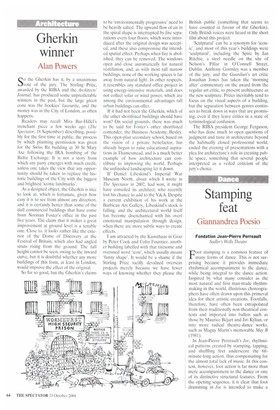Gherkin winner
Alan Powers
So the Gherkin has it, by a unanimous vote of the jury. The Stirling Prize, awarded by the RIBA and the Architects' Journal, has produced some unpredictable winners in the past, but the large green cone was the bookies' favourite, and the money was in the City of London, as often happens.
Readers may recall Mira Bar-Hillel's trenchant piece a few weeks ago (The Spectator, 18 September) describing, possibly for the first time in public, the process by which planning permission was given for the Swiss Re building at 30 St Mary Axe following the IRA bombing of the Baltic Exchange. It is not a story from which any party emerges with much credit, unless one takes the view that any opportunity should be taken to replace the historic buildings of the City with the biggest and brightest 'iconic landmarks'.
As a designed object, the Gherkin is nice to look at, which is fortunate, given how easy it is to see from almost any direction, and it is certainly better than some of the dull commercial buildings that have come from Norman Foster's office in the past five years. The claim that it makes a great improvement at ground level is a tenable one. Close to, it looks rather like the exterior of the Dome of Discovery at the Festival of Britain, which also had angled struts rising from the ground. The full height cannot be seen, owing to the inward curve, but it is doubtful whether any more buildings of this form, at least in London, would improve the effect of the original.
So far so good, but the Gherkin's claims to be 'environmentally progressive' need to be heavily salted. The upward flow of air in the spiral shape is interrupted by fire separations every four floors, which were introduced after the original design was accepted, and these also compromise the intended spatial effect. Perhaps when fire is abolished, they can be removed. The windows open and close automatically for natural ventilation, and, as with most tall narrow buildings, none of the working spaces is far away from natural light. In other respects, it resembles any standard office project in using energy-intensive materials, and does not collect solar or wind power, which are among the environmental advantages tall urban buildings can offer.
If it had not been the Gherkin, which of the other shordisted buildings should have won? On social grounds, there was much to be said for Foster's other shortlisted contender, the Business Academy, Bexley. This open-plan secondary school, based on the vision of a private benefactor, has already begun to raise educational aspirations in Thamesmead, and is a much better example of how architecture can contribute to improving the world. Perhaps the unfinished landscaping let it down.
If Daniel Libeskind's Imperial War Museum North, about which I wrote in The Spectator in 2002, had won, it might have consoled its architect, who recently lost his chance to add to the V&A. Despite a current exhibition of his work at the Barbican Art Gallery, Libeskind's stock is falling, and the architectural world itself has become disenchanted with his overt emotional manipulation through design, when there are more subtle ways to create effects.
I am attracted by the Kunsthaus in Graz by Peter Cook and Colin Fournier, another building labelled with that tiresome and overused word 'icon', which usually means 'funny shape'. It would be a shame if the Stirling Prize tacitly devalued overseas projects merely because we have fewer ways of knowing whether they please the British public (something that seems to have counted in favour of the Gherkin). Only British voices were heard in the short film about this project.
'Sculptural' can be a synonym for 'iconic', and most of this year's buildings were 'sculptural', including the Spire by Ian Ritchie, a steel needle on the site of Nelson's Pillar in O'Connell Street, Dublin. Anthony Gormley was a member of the jury, and the Guardian's art critic Jonathan Jones has taken the `morning after' commentary on the award from the regular art critic, to present architecture as the new sculpture. Prizes inevitably tend to focus on the visual aspects of a building, but the separation between genres continues to break down in ways that are promising, even if they leave critics in a state of terminological confusion.
The RIBA president George Ferguson, who has done much to open questions of judgment and taste in architecture beyond the habitually closed professional world, ended the evening of presentations with a plea for architecture's role in creating public space, something that several people interpreted as a veiled criticism of the jury's choice.
























































































 Previous page
Previous page